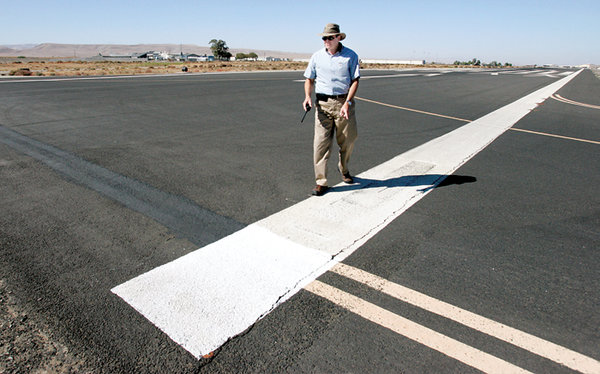 Turbo jets and turbo propeller aircraft will now be more common at Tracy Municipal Airport, following a four-foot addition to its main runway on Oct. 2.
Turbo jets and turbo propeller aircraft will now be more common at Tracy Municipal Airport, following a four-foot addition to its main runway on Oct. 2.
According to airport coordinator Bruce Ludeman, it wasn’t until a recent measurement that airport officials discovered the actual measurements for the east-west runway — officially Runway 12/30 — was 3,996 feet. Ludeman said the goal was to ensure the runway was at least 4,000 feet, which would designate Tracy as a medium size airport under Caltrans and allow more pilots to land their planes at the airport at the southern end of Tracy Boulevard.
“The magic number was to get it (runway) over 4,000 (feet),” Ludeman said. “Filled in the missing pavement to bring it to 4,000 feet, 2 inches. We knew what we needed, and we did a little extra.”
Ludeman said pilots of larger aircraft, including many with turbo jet and turbo propeller engines, complained they couldn’t fly into Tracy Municipal Airport because their insurance companies wouldn’t cover landings at airports with runways shorter than 4,000 feet.
“Many types of aircraft have that limitation placed on them by their insurance companies,” Ludeman said. “Many, many airports are 4,000 feet.”
Over the course of two days, starting Oct. 1, the airport workers laid the asphalt at the end of the runway, and the second day they added the striping with reflective glass beads to make the lines reflective and brighter, Ludeman said.
Some pilots said the work was long overdue.
“It’s a lot better, especially for the city,” Tracy Airport Association Vice President Dave Anderson said. “Big economic opportunity for the city of Tracy. You need the ability to bring those guys (aircraft) into Tracy and bring high-paying, high-tech jobs to the city.”
“We’re pretty excited about it, but that’s a small step,” Anderson said.
According to Parks and Community Services Director Rod Buchannan, whose department oversees airport operations, the lengthening of the runway was not an extension.
He said the work corrected a previous pavement project that mismarked the runway’s length.
“Basically filled in a hole at the end (of the runway),” he said. “Small little depression at the end of the runway. It was patching. It had to be patched…”
The re-measuring of the runway was a joint decision of the Tracy City Council and the Transportation Advisory Commission, made during a meeting Oct. 18, 2011, Buchannan said.
At that meeting, the two boards identified a number of airport improvement projects, which included confirming the runway’s length. “At that point, we found it was mismarked and filed a notice to airmen that people flying into the airport that the runway was 3,996 (feet),” Buchannan said. “And that was confirmed.”
Steve Stuhmer, the owner of airport fuel provider Tracy Air, told the City Council at a Tuesday, Oct. 16, meeting that his business will benefit from the “critical” decision to restore the runway.
Fuel sales have been adversely impacted by the sub-4,000-foot runway.
“You made a very good move in taking that direction,” Stuhmer said just before the council accepted a report detailing the improvement made at the airport.
Buchanan said having the length restored to beyond 4,000 feet was also important when it comes to finding funding for a repair to the airport’s runways and taxiways, which pilots have repeatedly claimed are in poor condition.
Now, Buchanan said the city can seek Federal Aviation Administration funding to repave the airport.
That’s critical, he said, because the project is estimated to cost $2 million, Buchanan said, meaning the $150,000 the city gets annually from the federal government for the airport would not be enough.
On Oct. 2, the City Council approved an agreement with R.W. Brandley, a consulting airport engineer, to create a pavement maintenance management plan. Buchannan said it was an important first step to determine the best approach to improve the pavement at the Tracy Airport.
The pavement study will be conducted in October and completed in December; followed by an airport capital improvement plan that will be submitted to the City Council in January 2013.
Airport officials will then seek FAA approval in February 2013, and will accept bids on the project in April or May 2013. It’s expected to be complete by July or August of 2013.
Project consultant Ed Lovell said the timeframe depends on the scope, cost and the city’s ability to obtain funding. He said the timeline was a rough outline from Brandley’s firm.
• Editor Jon Mendelson contributed to this report. • Contact Denise Ellen Rizzo at 830-4225 or [email protected].
Read more: Tracy Press – Re lined runway means more aircraft for Tracy
